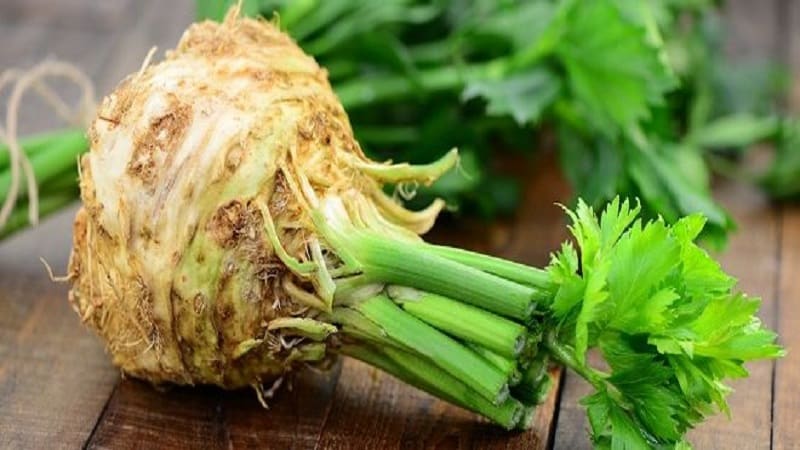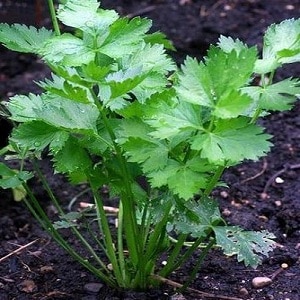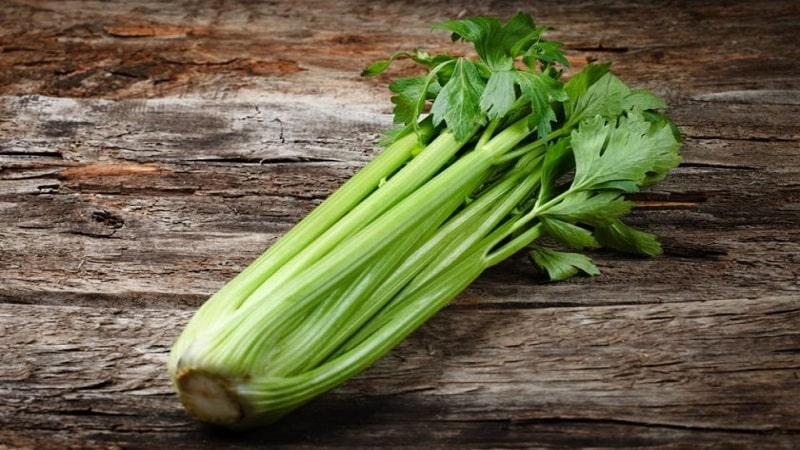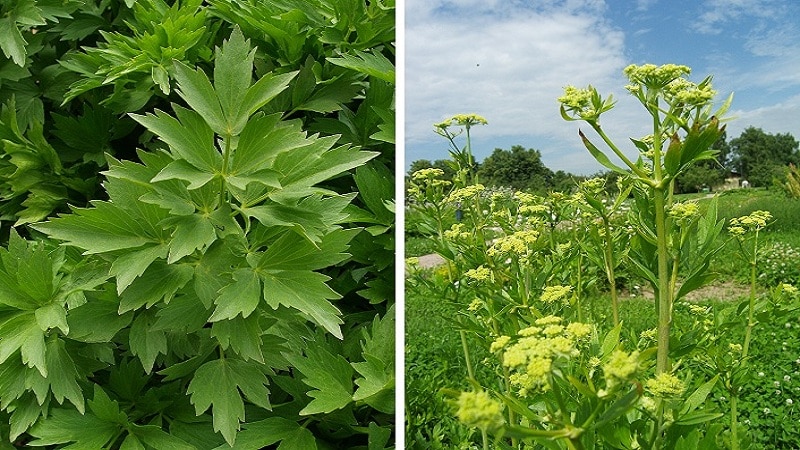What is the difference between lovage and celery or are they the same thing?
Celery and lovage are plants from the Apiaceae family. They are similar in appearance and have a similar aroma. Both cultures are rich in composition and have healing properties. However, there are features that distinguish them from each other. We’ll talk about the similarities and differences between celery and lovage in this publication.
Lovage: plant description
Lovage (lat. Levisticum officinále) is a medicinal perennial from the Apiaceae or Celery family, native to Southern Europe. Natural habitat - Iran, Afghanistan, Mediterranean. It does not grow wild in Russia. It is cultivated in garden plots.
The root is thick, large, brown in color with a spicy aroma. Erect hollow stems grow up to 2-2.5 m in height. The leaves are dark green in color, shiny, twice or thrice pinnately dissected.
The plant blooms with small, yellow-green or white-yellow flowers. The inflorescences are complex, umbrella-shaped. The flowering period is from June to August. Reproduction by bushes and seeds. The plant is frost-resistant and has a strong aroma reminiscent of celery.
In the photo - lovage.

Chemical composition and benefits
Lovage contains:
- essential oil - 0.1-2.7%;
- D-α-terpineol;
- cineole;
- acetic, isovaleric and benzoic acid;
- butylphthalide;
- ligustilide (substance responsible for aroma);
- lecithin - 0.9%;
- falcarindiol - 0.06%;
- resins;
- gum;
- organic acids - angelic and malic;
- starch;
- Sahara;
- terpenes - α-terpineol, carvacrol, sesquiterpenes, isovaleric acid;
- furocoumarins - psoralen and bergapten;
- tannins and minerals;
- ascorbic acid - 119 mg;
- carotene - 5 mg;
- routine
Useful properties of the plant:
- relieves pain;
- has an anticonvulsant effect;
- promotes the removal of sputum;
- relieves emotional stress;
- removes bile;
- reduces gas formation;
- has a diuretic effect;
- promotes rapid healing of wounds;
- disinfects.
Features of application
Lovage, a plant that looks similar to celery, is widely used in folk medicine and cooking. Its essential oil is an aphrodisiac. It is applied to the skin to attract the opposite sex. The aromatic oil is also used for culinary purposes.
Juice from the leaves tones, normalizes the gastrointestinal tract, reduces gas formation, and improves appetite. It is used as a mild laxative.
In cooking, the roots, leaves and stems of lovage are used to add a special aroma to dishes made from vegetables, meat, cereals, fish, and cottage cheese. Dried root is added to marinades and drinks.
Dried herbs are sprinkled on soups, sauces and gravies. It makes a flavorful seasoning for fish. To do this, take thyme, yarrow and lovage in equal proportions.
Ground seeds are used to flavor salt (1:1).
The leaves of the fresh plant are placed in salads of cucumbers, sweet peppers, radishes, and tomatoes.
Lovage is used in medicine to treat obesity, rheumatism, pathologies of the liver, heart, and lungs. The plant helps get rid of gout, anemia, migraine, dropsy.
The leaves are used to strengthen hair follicles, eliminate dandruff, age spots and freckles, pustular rashes, and trophic wounds.
Celery: plant description
Celery is a biennial plant from the Apiaceae family, native to the Mediterranean, and distributed throughout the world. Roots, stems and leaves are used for food. The plant is considered a powerful aphrodisiac. Varieties of culture - root, petiole and leaf celery.
Plant height is 70-100 cm. The color of the leaves with jagged edges is light green. The basal leaves are darker than those formed on the stem and have fleshy petioles.
In the first year, the plant grows greenery and large rhizomes. In the second year, a peduncle with seeds is formed, after which the plant dies.
The culture is demanding in terms of location and care. Young plants are not resistant to frost, so seedlings are planted in the ground no earlier than the last days of May or early June.
Reference. Celery leaves resemble parsley leaves, but have a different shape and pattern. Their aroma is spicier, their taste is sharper.
The inflorescences are small, greenish, sometimes whitish. The seeds are small and brown.
Root varieties are represented by round, fleshy, cream-colored root vegetables. The above-ground part is not used for food due to the long growing season - about 200 days. If you remove the leaves before the root crop ripens, the above-ground mass will not be enough to form an underground one.
The photo shows root celery.

Leafy varieties are cultivated to produce juicy greens. Some of them form hard foliage, unsuitable for fresh consumption. It is dried or canned. Other varieties produce many tender leaves for fresh consumption.
The photo shows leaf celery. 
Petiole celery is not as popular in Russia as, for example, in European countries. The selection of varieties is small, mostly of imported origin. Petiole varieties are divided into green and self-bleaching.
To bleach green petioles artificially, high hilling is carried out a month before harvesting, without covering the foliage.
The photo shows stalked celery. 
Chemical composition and beneficial properties
The chemical compositions of celery stalks and roots differ.
The table shows the vitamin and mineral composition of petiole celery (per 100 g).
| Name | Content | Norm |
| Vitamin A | 750 mcg | 900 mcg |
| Beta carotene | 4.5 mg | 5 mg |
| Vitamin B1 | 0.02 mg | 1.5 mg |
| Vitamin B2 | 0.1 mg | 1.8 mg |
| Vitamin B4 | 6.1 mg | 500 mg |
| Vitamin B5 | 0.246 mg | 5 mg |
| Vitamin B6 | 0.08 mg | 2 mg |
| Vitamin B9 | 21 mcg | 400 mcg |
| Vitamin C | 38 mg | 90 mg |
| Vitamin E | 0.5 mg | 15 mg |
| Vitamin H | 0.65 mcg | 50 mcg |
| Vitamin K | 29.3 mcg | 120 mcg |
| Vitamin PP | 0.5 mg | 20 mg |
| Potassium | 430 mg | 2500 mg |
| Calcium | 72 mg | 1000 mg |
| Silicon | 2.9 mg | 30 mg |
| Magnesium | 50 mg | 400 mg |
| Sodium | 200 mg | 1300 mg |
| Sulfur | 6.9 mg | 1000 mg |
| Phosphorus | 77 mg | 800 mg |
| Chlorine | 26.8 mg | 2300 mg |
| Iron | 1.3 mg | 18 mg |
| Iodine | 7.5 mcg | 150 mcg |
| Cobalt | 0.86 mcg | 10 mcg |
| Manganese | 0.103 mg | 2 mg |
| Copper | 35 mcg | 1000 mcg |
| Molybdenum | 5.4 mcg | 70 mcg |
| Selenium | 0.4 mcg | 55 mcg |
| Fluorine | 4 mcg | 4000 mcg |
| Chromium | 2.1 mcg | 50 mcg |
| Zinc | 0.13 mg | 12 mg |
The table shows the vitamin and mineral composition of celery root (per 100 g).
| Name | Content | Norm |
| Vitamin A | 3 mcg | 900 mcg |
| Beta carotene | 0.01 mg | 5 mg |
| Vitamin B1 | 0.03 mg | 1.5 mg |
| Vitamin B2 | 0.06 mg | 1.8 mg |
| Vitamin B4 | 9 mg | 500 mg |
| Vitamin B5 | 0.4 mg | 5 mg |
| Vitamin B6 | 0.15 mg | 2 mg |
| Vitamin B9 | 7 mcg | 400 mcg |
| Vitamin C | 8 mg | 90 mg |
| Vitamin E | 0.5 mg | 15 mg |
| Vitamin H | 0.1 mcg | 50 mcg |
| Vitamin K | 41 mcg | 120 mcg |
| Vitamin PP | 1.2 mg | 20 mg |
| Potassium | 393 mg | 2500 mg |
| Calcium | 63 mg | 1000 mg |
| Silicon | 29 mg | 30 mg |
| Magnesium | 33 mg | 400 mg |
| Sodium | 77 mg | 1300 mg |
| Sulfur | 15 mg | 1000 mg |
| Phosphorus | 27 mg | 800 mg |
| Chlorine | 13 mg | 2300 mg |
| Iron | 0.5 mg | 18 mg |
| Iodine | 0.4 mcg | 150 mcg |
| Cobalt | 1.8 mcg | 10 mcg |
| Manganese | 0.158 mg | 2 mg |
| Copper | 70 mcg | 1000 mcg |
| Molybdenum | 4 mcg | 70 mcg |
| Selenium | 0.7 mcg | 55 mcg |
| Fluorine | 4 mcg | 4000 mcg |
| Chromium | 2.4 mcg | 50 mcg |
| Zinc | 0.33 mg | 12 mg |
Beneficial features celery:
- polysaccharides provide an anti-inflammatory effect;
- antioxidants protect cells from destruction and prevent the formation of malignant tumors;
- pectins remove toxins, radionuclides, nicotine, alcohol, narcotic substances;
- Vitamin C supports the body’s protective function and restores blood flow;
- proteins and fatty acids are easily digestible and have a positive effect on digestive function;
- Regular use of the product increases libido;
- B vitamins strengthen the walls of blood vessels, normalize blood pressure, reduce cholesterol levels, increase hemoglobin;
- the plant has antiallergic, laxative, antiseptic, tonic effects;
- celery reduces swelling, improves memory, prevents the development of Alzheimer's disease;
- regulates metabolism;
- luteolin in the product relieves inflammation and rejuvenates the body;
- phthalides and polyacetylenes reduce the level of carcinogens;
- celery regulates the menstrual cycle and reduces the unpleasant symptoms of menopause.
Features of application
Celery is often included in menus for losing weight and arrange fasting days with him. It is one of the negative calorie foods. This means that the body spends more energy to digest it than it receives.Celery contains fiber, which helps digest other foods.
Celery juice is used for cosmetic purposes - for the preparation of anti-acne and antiseptic agents.
Celery has long been used to eliminate unpleasant odor from the mouth. Fresh stems are a natural alternative to toothbrush and floss. The rough and fibrous stems effectively clean the teeth and tongue.
An extract is made from celery seeds, which has analgesic, anti-inflammatory and diuretic effects; it is used in the treatment of genitourinary tract infections.
A decoction of the seeds and freshly squeezed juice from the root are used to treat bursitis.
Celery is widely used in cooking. Fragrant petioles and fresh leaves are eaten fresh with light sauces, added to vegetable, meat, fish, fruit salads, and used to serve alcoholic cocktails. The petioles are suitable for pickling and salting, and preparing filling for pies.
The root is added to salads, stewed and baked, pickled, and dried.
The seeds are placed in marinades, soups, meat dishes, and salads.
A decoction is prepared from the leaves and seeds, and juice is prepared from the roots for use in folk medicine.
How to recognize lovage
Are celery and lovage the same thing? At first glance, it is difficult to distinguish the plants. Experienced gardeners advise paying attention to the color of the leaves: lovage leaves are darker and the petioles look thinner. The top leaves of celery and lovage look almost identical and have a similar aroma.
Characteristics of lovage:
- perennial;
- propagated by seeds and division of rhizomes;
- adapts to any growing conditions;
- plant height reaches 2 m;
- inflorescences are large;
- the smell is spicy, pronounced;
- the taste is islandy, with bitterness.
Read also:
Useful properties and calorie content of rice.
How is potassium nitrate useful for cucumbers during the fruiting period?
Similarities and differences between cultures
Plants have common characteristics that cause confusion:
- belong to the Umbrella family;
- have a similar shape and foliage pattern;
- identical smell;
- general area of application - traditional medicine, cooking.
The table shows the main differences between cultures.
| Characteristic | Celery | Lovage |
| Life cycle | Biennial | perennial |
| Variety | Leaf, root, petiole | Sheet |
| Sustainability | Does not withstand minimal frost | Frost-resistant |
| Plant height | 1m | 2-2.5 m |
| Leaves | Light green, tender | Dark green, rough |
| Eating | All parts of the plant are edible | Only leaves are used |
| Taste | Tender, spicy | Spicy, bitter |
| Type of reproduction | Seminal | Seed and root |
Conclusion
Lovage and celery are not the same thing, although the plants belong to the Apiaceae family and have similarities in appearance. Celery is a unique crop that has no analogues in the world. Sometimes it is put on the same level as ginseng due to its healing properties. Root vegetables and leaves contain valuable amino acids, carotene, asparagine, nicotinic acid, tyrosine, and essential oils. Lovage has a number of healing properties and is widely used in folk medicine. The leaf part is dried, added to vegetable salads, and the seeds are added to salt for flavor.
The differences relate to the characteristics of cultivation, resistance to frost, use in cooking, taste and aroma. In lovage, only the leaf part is used for food; in celery, the roots, petioles and foliage are used.Both lovage and celery have medicinal properties and have a beneficial effect on well-being, appetite, skin, hair and potency.